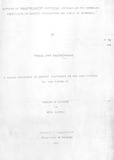| dc.description.abstract | High crop production cost, which is a major constraint limiting agricultural production in Kenya, can be reduced by partial substitution of N fertilizers with biologically fixed nitrogen. This study was conducted to determine whether the
transformation of atmospheric N2 by Bradyrhizobium_japonicum
bacteria into forms readily available for use by soybean (Glycine max (L.) Merrill) can substitute for or supplement N fertilizer in soybean production. The effects of five levels of N (0, 20, 40, 80 and 160kgN/ha) and inoculation with NUM 504 and NUM 508 Bradyrhizobium japonicum strains on growth, nodulation and yield of Duiker and Sable varieties of soybeans were investigated under greenhouse and field conditions on Humic and Rhodic Ferralsols, respectively. The Humic and Rhodic Ferralsols had a mean N content of 0.17 and 0.2%, respectively at 0-20cm depth and were completely devoid of Bradyrhizobium japonicum bacteria.
Inoculation significantly (P<0.001) increased the shoot dry weights and plant heights of the plants grown in the greenhouse. Plants inoculated with NUM 508 in the field had significantly (P=0.05) higher percent N in the shoots and grains compared with the control. Nitrogen significantly (P<0.01) increased the percent N content of the grains. Interaction between N and inoculation with regard to grain yield was significant (P<0.05); NUM 508 produced the highest grain yield, i.e., 4413.67kg/ha at
xii
zero-N level, compared to 3846.20kg/ha for the uninoculated treatments at the same N level. Nitrogen at 20, 80, and 160kgN/ha increased the grain yields of non-inoculated plants compared to the zero-N levo] . The grain yields of zero, 20, 80 and 160kgN/ha of non-inoculated treatments were 3846.20, 4161.09, 4117.79 and 4066.33kg/ha, respectively. Increasing N levels decreased the grain yields of inoculated plants linearly. The grain yields of plants inoculated with NUM 504 and NUM 508 decreased from 4135.58 and 4413.67kg/ha at zero-N level to 3264.51 and 3238.42kg/ha at 160kgN/ha, respectively.
The results indicate that application of N decreases nodulation of soybeans. Inoculation is absolutely necessary for soybean nodulation. A significant (P<0.05) variety x strain interaction existed for nodule dry weights and grain size under field conditions. NUM 508 formed heavier nodules with Duiker variety than NUM 504 while the latter formed heavier nodules with Sable variety than the former strain. A similar trend was observed with grain size. NUM 508 produced bigger grains with Duiker variety than NUM 504, but the latter produced bigger grains with Sable variety than the former strain. Inoculation wit out N fertilizer increased the grain yields of soybeans but N fertilizer improved the grain yields of uninoculated soybeans only | |

